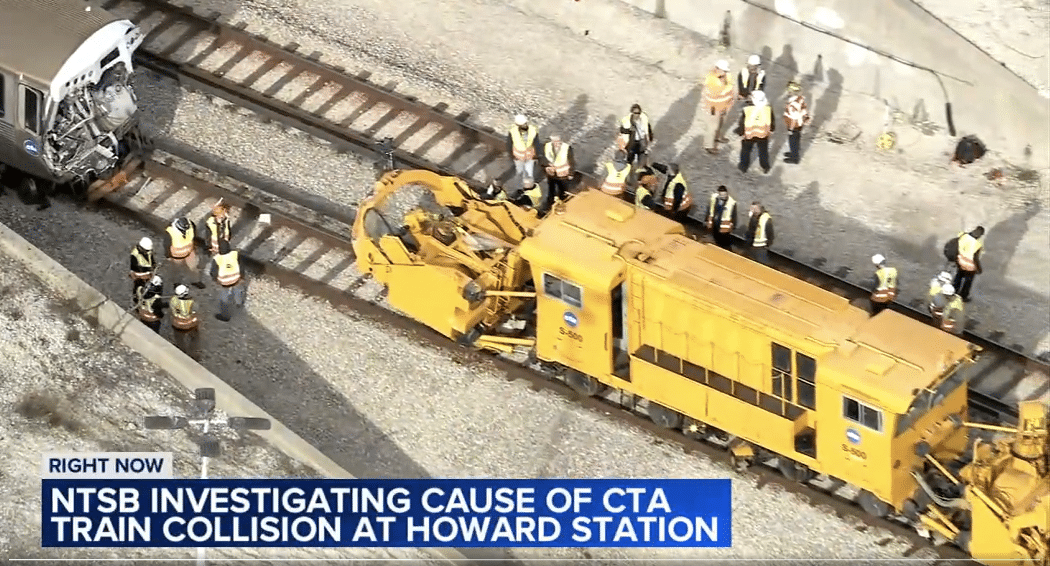The CTA Yellow Line Collision Sent 23 People to the Hospital
The silver lining of yesterday’s high-speed crash for the Chicago Transit Authority (CTA) Yellow Line at the Howard rail yard is that so far, everyone has survived. So, we wanted to start with the good news.
The bad news of course, is that 38 people were injured, including the 37 on board who were injured; 23 of them were hospitalized. According to CBS News, 31 of those folks were passengers; the rest were CTA employees. Fifteen ambulances were called to the scene, but our emergency services folks got every single one of them off that train – and for that, we are grateful. We are keeping all of them in our hearts today, and hoping they all make a full recovery.
What caused the Yellow Line collision?
The Yellow Line train hit a snow fighter locomotive, which is essentially a big snowplow for railroad tracks. We took a screen capture of ABC 7’s new footage so you could see the locomotive’s position.

As you can see, the whole front of the CTA train caved in, which makes it even more miraculous that everyone survived.
Per CBS News:
The collision took place right at the point where the Yellow Line trains enter the rail yard from the north and west on their route, heading out of the trench below grade level and into a potentially dangerous curve, according to transportation expert and DePaul University professor Joe Schwieterman.
Habermehl reported the impact of the crash caused the lead-end wheel set of the Yellow Line train to derail. The snow-fighting unit also sustained some damage to the back.
But this is the strange part: it was about 60° in Chicago yesterday. Why on earth was a snowplow on the tracks at all, let alone on a track with a commuter train? Because according to CBS, one of the people injured (the 38th person) was operating that snowplow at the time, which means someone knew thar plow would be on the tracks; someone had to give the “okay” for it to be there.
In fact, according to ABC News, “less than two hours before [the crash], radio traffic for the CTA obtained by the I-Team indicates train operators were informed about personnel working in the area where the collision would later occur” (emphasis ours).
Our point is, someone knew. People were informed.
This should have been an avoidable train collision
Cars and some trucks come equipped with software that can help drivers avoid a crash. Trains have programs like that, too: it’s called Positive Train Control (PTC) and its only function is to keep trains (and the people on them) safe by preventing collisions and derailments.
The Metra trains in Chicago are all equipped with PTC; they have to be, under federal mandate. It’s why you hear those announcements like “Outbound train XYZ is delayed because of Positive Train Control issues.” The delays can be rough, we know, but they’re keeping us safe.
But CTA is exempt from installing PTC “because the CTA isn’t linked to the national rail network, and doesn’t fall under federal railroad regulations.” In other words, the Federal Railroad Administration doesn’t have control over these trains so it can’t force CTA to implement a potentially life-saving system.
Just for the record, “the Chicago Transit Authority (CTA) operates the nation’s second largest public transportation system” (emphasis ours) serving 35 suburbs. Its rapid transit system has 1,492 rail cars on eight different tracks, serving 145 stations; per the CTA, these trains make about 2,318 trips per day. The most recent data we could find (on Wikipedia, not CTA’s website) says that in 2022, the annual ridership of their trains was 103,524,900 people.
Over 103 million people a year get on CTA trains. You know what the annual ridership for Metra trains was in 2022? It was 23,726,400 – just over a fifth of the annual CTA ridership.
To be clear: a commuter train system with five times the number of riders is NOT required by federal mandate to install PTC, and so the City of Chicago has chosen not to do it.
What legal options do you have after a train collision or derailment?
Your legal options after a train collision or derailment are determined, in part, by the operating agency or authority.
For example, if this collision had involved an Amtrak train, you would file your claim against Amtrak. Because Amtrak is a “quasi-public corporation,” which means it’s a private company whose shares are owned by the U.S. government, you can actually sue the company for damages. But unlike suing, say, a negligent driver, where you can seek compensation that is commensurate with your losses, there are caps for Amtrak claims.
But suing the Chicago Transit Authority is a much different scenario. First, the statute of limitations is different. Instead of two years to file a claim, you only have one year. Second, CTA does have certain protections in place, including a MUCH higher threshold for the claim. Now, in this instance, it would seem pretty obvious that CTA bears liability: it controls the Yellow Line train as well as the snowplow it hit, and there is a recording of CTA personnel talking about the work on the line. But that doesn’t mean the case will be easy. CTA pays out claims from its own budget – it will fight to keep every dime.
This is why you want an injury attorney with experience successfully bringing claims and lawsuits against the CTA. The attorneys of Gainsberg Injury and Accident Lawyers have that experience. We’ve represented workers in FELA claims as well as non-employees in cases against the CTA. We know how to work quickly, efficiently, and effectively so you are not time-barred, and we know what it takes to win this type of case.
If you or a loved one were seriously injured while riding a CTA, Metra, or Amtrak train, you want experienced legal counsel on your side. Gainsberg Injury and Accident Lawyers wants to help. Our Chicago train accident lawyers have the resources, experience, and skill these types of complex claims require. We invite you to call us or fill out our contact form to get started with your free consultation.

Attorney Neal Gainsberg has spent the last 20+ years fighting to protect the rights of the injured in Chicago and throughout Illinois. For dedicated legal help with a personal injury, car accident, or wrongful death matter, contact Gainsberg Injury and Accident Lawyers in Chicago for a free consultation.
